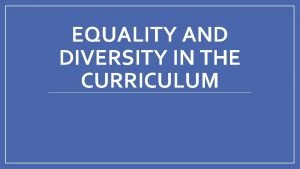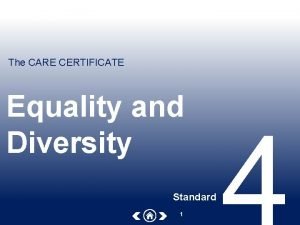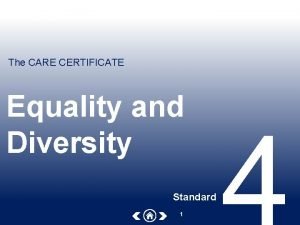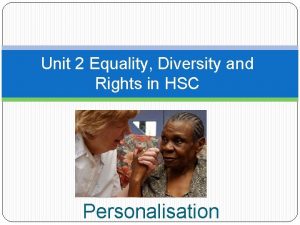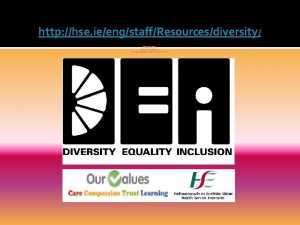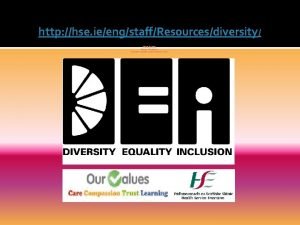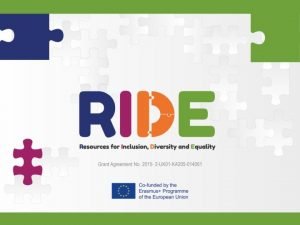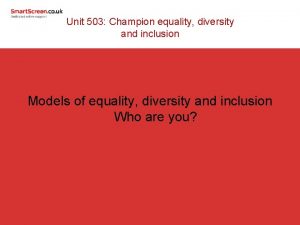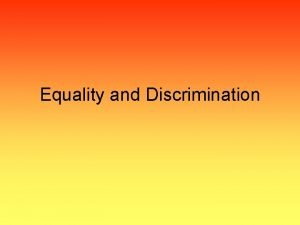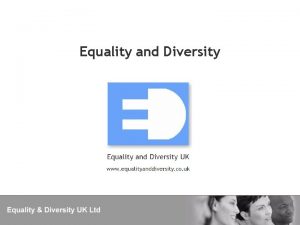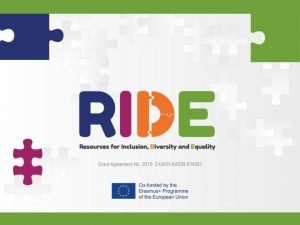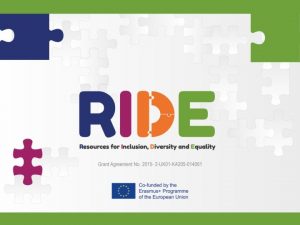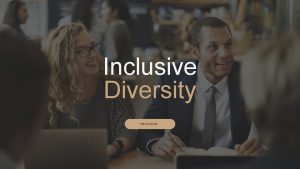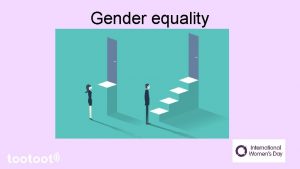EQUALITY AND DIVERSITY IN THE CURRICULUM Inclusive curriculum









- Slides: 9

EQUALITY AND DIVERSITY IN THE CURRICULUM

Inclusive curriculum An inclusive curriculum is one “where all students’ entitlement to access and participate in a course is anticipated, acknowledged and taken into account”[1] Drivers Uo. E Task group • Equality legislation - Mapping current practices • Access and inclusion agenda - Benchmarking • Internationalisation - Consultation with staff and students 1. Morgan H. and Houghton, AM. (2011) Inclusive curriculum design in higher education. https: //www. heacademy. ac. uk/system/files/resources/introduction_and_overview. pdf

A model for embedding equality and diversity in the curriculum Embedding equality and diversity in the curriculum is: the creating of learning, teaching and assessment environments and experiences that proactively eliminate discrimination, promote equality of opportunity and foster good relations in a manner that values, preserves and responds to diversity. Inclusivity Diversity Inclusivity Hanesworth, P. (2015) Embedding equality and diversity in the curriculum. https: //www. heacademy. ac. uk/system/files/eedc_model_for_learning_and_teaching_practitioners. pdf Equality and diversity competence

Defintions The ability to function with awareness, knowledge and interpersonal skill when engaging people of different backgrounds, assumptions, beliefs, values and behaviours (Hogan, 2007, p 3) Equality and diversity competence Diversity Inclusivity “the ways in which pedagogy, curricula and assessment are designed and delivered to engage students in learning that is meaningful, relevant and accessible to all. It embraces a view of the individual and individual difference as the source of diversity that can enrich the lives and learning of others (Hockings 2010, p. 1). “ ‘the active, intentional, and ongoing engagement’ (p. 6) with differences in a purposeful manner so as to increase one’s diversity-related competencies [where difference is] both individual, such as personality, learning styles, and life experiences, and group or social, such as race/ethnicity, gender, country of origin, religion (p. 6). According to this definition, diversity refers not to the presence of difference in student demographics or course content, but to the act and process of engaging those differences in an intentional, purposeful

Principles of Embedding Equality, Diversity and Inclusivity in the Curriculum Uo. E Principles https: //www. ed. ac. uk/academic-services/projects/promoting-inclusion-equality-diversitycurriculum/principles • Recognise and promote diversity in sources of ideas/knowledge • Ensure curriculum is relevant and engaging • Curriculum should be challenging, unconstrained and respectful • Adopt diverse learning teaching and assessment • Academic freedom and excellence • Seek ways to engage staff and students Also see Morgan and Houghton 2011

Some examples • History, Classics and Archaeology –project on developing an accessible and inclusive pedagogical approach to fieldwork. • Moray House School of Education - project on lecture recording for inclusive education. • Philosophy, Psychology and Language Sciences -project on ‘Diversity Reading List project in Philosophy’. • MBCh. B – introduction of LGBT+ health teaching session in year 1 curriculum • School of Informatics - third year course on professional issues addresses issues regarding discrimination in IT • School of Physics - project on understanding the influence of gender on academic achievement in physics

Elements of curriculum design AIMS AND OBJECTIVES LEARNING OUTCOMES ACADEMIC AND COMPETENCE STANDARDS CONTENT/SYLLABUS TEACHING METHODS LEARNING ACTIVITIES ASSESSMENT AND FEEDBACK TEACHING AND LEARNING MATERIALS

MBCh. B: Equality, Diversity and Inclusivity in the Curriculum (EDIC) Working Group • Staff-student partnership • Remit • Activities will include: • to enhance learning, assessment and teaching approaches to promote equality and diversity competence: “the ability to function with awareness, knowledge and interpersonal skill when engaging people of different backgrounds, assumptions, beliefs, values and behaviours” [2] Map current activities (curriculum content, assessment, learning and teaching approaches). Identify and develop ways to engage with equality and diversity within the curriculum (modifying existing content and developing new content) in an intentional and purposeful manner. • Develop bespoke guidance for staff on embedding inclusion, equality, and diversity into the MBCh. B curriculum • • 2. (Hogan 2007, Four skills of cultural diversity competence: a process for understanding and practice. Brooks/Cole Cengage Learning p. 3).

What does this mean for us? What do we currently do? What can/should we do?
 Embedding equality and diversity in the curriculum
Embedding equality and diversity in the curriculum Equality and diversity care certificate
Equality and diversity care certificate Care certificate equality and diversity
Care certificate equality and diversity Unit 2: equality and diversity in the community
Unit 2: equality and diversity in the community Hse diversity equality and inclusion strategy
Hse diversity equality and inclusion strategy Mona talents priority
Mona talents priority Define equality and diversity
Define equality and diversity Unit 503
Unit 503 Unit 2 equality diversity and rights
Unit 2 equality diversity and rights Formal and substantive equality
Formal and substantive equality
